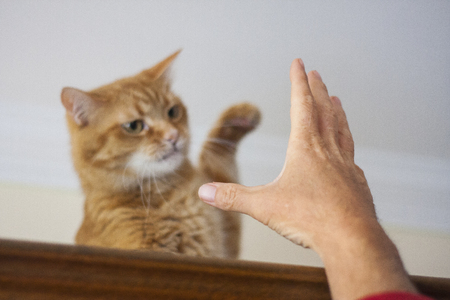1. Understanding Feline Social Structures
Cats have unique social structures that differ from pack animals like dogs. Understanding how cats naturally interact can help you create a peaceful multi-cat household. Unlike dogs, cats are more solitary by nature, but they can form complex social hierarchies when living together.
How Cats Establish Hierarchies
Cats don’t have a strict alpha system like dogs, but they do establish territories and social rankings through body language, scent marking, and interactions. Some cats may take on more dominant roles, while others prefer to be more submissive or independent.
Signs of Dominance and Submission
| Dominant Cat Behaviors | Submissive Cat Behaviors |
|---|---|
| Blocking access to food or litter boxes | Avoiding confrontation |
| Staring down other cats | Looking away or lowering body posture |
| Scent marking (rubbing face on objects) | Hiding or retreating from conflict |
| Claiming high perches | Using less-preferred areas |
The Role of Territory in Multi-Cat Homes
Cats are territorial creatures, and conflicts often arise when their personal space is invaded. In a multi-cat home, its important to provide enough space for each cat to establish their own areas. This includes having multiple feeding stations, litter boxes, and resting spots.
Tips for Reducing Territorial Disputes
- Provide multiple vertical spaces like cat trees and shelves.
- Create separate feeding areas to prevent food aggression.
- Ensure there are enough litter boxes (one per cat, plus one extra).
- Use pheromone diffusers to create a calming environment.
- Avoid sudden changes in the household setup that could stress your cats.
2. Creating a Peaceful Environment
One of the best ways to reduce conflict in a multi-cat household is by setting up your home in a way that minimizes territorial disputes. Cats are naturally territorial animals, and when they feel like their space is being invaded, tension can arise. By providing enough resources and designated areas for each cat, you can help prevent fights and create a more peaceful environment.
Provide Enough Space
Cats need their own personal space to feel safe and secure. If they feel crowded, they may become stressed or aggressive toward other cats. Make sure your home has enough room for each cat to retreat when needed.
Use Cat Trees and Vertical Spaces
Cats love climbing and observing their surroundings from high places. Installing cat trees, shelves, or window perches allows your cats to have their own territory without taking up floor space. This also helps reduce conflicts by giving them more options for where to rest and observe.
Ensure Adequate Litter Boxes
A common source of tension between cats is litter box access. To avoid problems, follow the “one litter box per cat plus one extra” rule. Place them in different locations throughout your home so that no single cat can guard all of them.
| Number of Cats | Recommended Number of Litter Boxes |
|---|---|
| 1 | 2 |
| 2 | 3 |
| 3 | 4 |
| 4 | 5 |
Create Hiding Spots and Safe Zones
Cats often seek out hiding spots when they feel overwhelmed or stressed. Providing hiding places such as covered beds, cardboard boxes, or enclosed cat condos can help them feel secure and reduce anxiety.
Separate Feeding Areas
Cats can be protective over their food, which may lead to conflicts during mealtime. To prevent food aggression, set up separate feeding stations in different areas of your home so that each cat can eat without feeling threatened.

3. Introducing New Cats the Right Way
Bringing a new cat into a home with existing cats can be challenging. A sudden introduction may lead to stress, aggression, and territorial disputes. By following a gradual introduction process, you can help your cats adjust smoothly and minimize conflict.
Step-by-Step Introduction Process
Introducing cats properly takes time and patience. Follow these steps to make the transition easier for both your new cat and your resident cats.
1. Set Up a Separate Space
Before bringing the new cat home, prepare a separate room with food, water, a litter box, and comfortable hiding spots. This allows them to adjust to their new environment without immediate interactions with other cats.
2. Use Scent Exchange
Swap bedding or rub a cloth on each cat and place it near the other’s space. This helps them get used to each others scent before meeting face-to-face.
3. Gradual Visual Introductions
After a few days, allow the cats to see each other through a baby gate or cracked door while still keeping them separated. Observe their reactions and proceed only if they appear calm.
4. Supervised Short Meetings
Once they seem comfortable with each others presence, introduce them in a controlled environment. Keep initial meetings short and monitor their body language closely.
5. Increase Interaction Time Gradually
If the first meetings go well, slowly increase their interaction time while supervising. Ensure there are multiple escape routes in case one cat feels overwhelmed.
Signs of Progress and Warning Signs
| Positive Signs | Warning Signs |
|---|---|
| Sniffing without hissing | Growling or prolonged hissing |
| Relaxed body language | Puffed-up fur or arched back |
| Playing or ignoring each other | Swatting or chasing aggressively |
Troubleshooting Common Issues
Cats Are Hissing or Growling Constantly
If your cats continue to hiss or growl at each other after several days, slow down the introduction process. Give them more time apart and increase scent exchange before reintroducing visual contact.
Aggressive Behavior Occurs During Meetings
If fights break out during supervised meetings, separate them immediately and try again later with shorter sessions. Reward calm behavior with treats to create positive associations.
Cats Avoid Each Other Completely
This is normal at first. Some cats take longer to feel comfortable around new companions. Ensure each cat has its own resources (food bowls, litter boxes) so they don’t feel forced into interactions.
A successful introduction requires patience, consistency, and close observation of your cats behavior. Taking it slow will help create a peaceful multi-cat household over time.
4. Recognizing and Managing Conflict
Living in a multi-cat household can be rewarding, but it also comes with challenges, especially when conflicts arise between your cats. Understanding the signs of tension and aggression early can help you take steps to restore harmony before things escalate.
Identifying Signs of Tension and Aggression
Cats communicate their discomfort in subtle ways before a conflict turns into a full-blown fight. Here are some common signs of tension and aggression:
| Behavior | Description |
|---|---|
| Ears Flattened | Ears pinned back or flattened against the head indicate fear or aggression. |
| Puffed-Up Fur | A cat with raised fur, especially on its back or tail, is trying to appear larger as a defensive response. |
| Staring or Blocking Pathways | If one cat blocks another from accessing food, litter boxes, or favorite spots, its a sign of dominance or bullying. |
| Loud Growling or Hissing | Cats growl and hiss when they feel threatened or want to warn another cat to stay away. |
| Paw Swiping or Biting | A quick swat may be a warning, but repeated swipes or biting can lead to serious fights. |
| Avoidance Behavior | If a cat hides more often or avoids certain areas, it may be feeling stressed due to another cats presence. |
Conflict Resolution Strategies
If you notice tension between your cats, try these strategies to ease conflicts and create a peaceful environment:
Create More Resources
Cats often fight over food, water, litter boxes, and resting spots. Make sure each cat has access to its own essentials. The general rule is to have one resource per cat plus one extra (e.g., three litter boxes for two cats).
Use Vertical Space
Cats feel more secure when they have high places to retreat to. Adding cat trees, shelves, or window perches can help them avoid confrontations by providing escape routes.
Pheromone Diffusers and Calming Aids
Synthetic feline pheromones, like Feliway diffusers, can help reduce stress and promote a sense of security in multi-cat households.
Avoid Punishing Aggressive Cats
Punishment can increase fear and anxiety, making conflicts worse. Instead of scolding or spraying water at an aggressive cat, redirect their attention with toys or treats.
Scent Exchange Technique
If two cats are having trouble getting along, try swapping their bedding or rubbing them with the same towel to help them get used to each others scent.
Gradual Reintroductions if Necessary
If fights become frequent, consider separating the cats for a while and reintroducing them slowly using positive reinforcement techniques.
Tension between cats is normal from time to time, but by recognizing early warning signs and applying these strategies, you can prevent serious conflicts and maintain a happy home for all your feline friends.
5. Enriching Their Lives to Reduce Stress
Keeping your cats mentally and physically stimulated is essential for maintaining harmony in a multi-cat household. Boredom and lack of activity can lead to stress, which may cause conflicts between cats. By providing engaging activities, you can help reduce tension and encourage positive interactions.
Interactive Toys for Mental Stimulation
Cats are natural hunters, and interactive toys mimic the excitement of hunting prey. Toys that move unpredictably or require problem-solving can keep your cats entertained while also giving them a healthy outlet for their energy.
- Feather wands: Great for interactive play sessions that mimic hunting.
- Laser pointers: Encourage movement but always end with a tangible toy reward.
- Electronic motion toys: Simulate prey-like movements to engage your cat’s instincts.
The Importance of Playtime
Regular play sessions help release pent-up energy and reduce aggression between cats. Aim for at least two structured playtimes per day, using different types of toys to keep things exciting. Engaging in play also strengthens the bond between you and your cats.
Puzzle Feeders for Mental Engagement
Puzzle feeders provide both mental stimulation and a slow-feeding approach, preventing food-related conflicts. These feeders make mealtime more engaging and rewarding.
| Puzzle Feeder Type | How It Helps |
|---|---|
| Treat balls | Cats must roll the ball to release kibble, encouraging activity. |
| Maze feeders | Cats navigate through obstacles to reach their food, slowing down eating. |
| Lick mats | Smeared with wet food or treats, these provide a calming feeding experience. |
Create Vertical Spaces for Exploration
Cats love to climb and observe their environment from above. Providing vertical spaces allows them to escape tense situations and feel more secure in their territory.
- Cattrees: Give cats a designated space to climb and rest.
- Shelves: Wall-mounted shelves offer extra vertical territory.
- Window perches: Allow cats to watch outdoor activity, keeping them entertained.
The Power of Routine
Cats thrive on routine, and predictable schedules help reduce stress. Keep feeding times, play sessions, and sleeping areas consistent so that all your cats feel secure in their environment.


